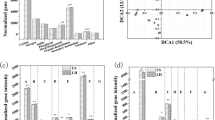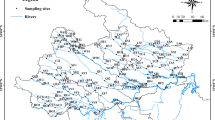Abstract
The relative abundance of functional genes used to quantify the abundance of functional genes in communities is controversial. Quantitative PCR (qPCR) technology offers a powerful tool for quantifying functional gene abundance. However, humic substances can inhibit qPCR in sediment/soil samples. Therefore, finding a convenient and effective quantitative analysis method for sediment/soil samples is necessary. The functional genes and physicochemical properties in sediments with different-level pollutions were analyzed in this study. Correlations between physicochemical properties and the relative abundance of functional genes were used to test whether relative abundance in gene prediction quantifies the abundance of functional genes. The abundance of functional genes could be corrected by multiplying the fluorescein diacetate (FDA) hydrolytic rates by the relative abundance of functional genes since the FDA assay has been widely used as a rapid and sensitive method for quantifying microbial activity in sediments. Redundancy analysis showed significant interrelations between the functional genes and the physicochemical properties of sediments. The relative abundance of functional genes is unreliable for quantifying the abundance of functional genes because of the weak correlation (R < 0.5, P < 0.05) between different pollutants and the relative abundance of functional genes. However, a significant positive correlation between concentrations of different pollutants and the activities of associated enzymes was obtained (R > 0.933, P < 0.05), which revealed that the abundance of functional genes could be reliably quantified by the relative abundance and FDA hydrolytic rate. This study proposed an alternative method besides qPCR to quantify the absolute abundance of functional genes, which overcomes the problem of humic interference in the quantitative analysis of sediment/soil samples.






Similar content being viewed by others
Data availability
The dataset used during the current study are available from the corresponding author on reasonable request.
References
Aßhauer KP, Wemheuer B, Daniel R, Meinicke P (2015) Tax4Fun: predicting functional profiles from metagenomic 16S rRNA data. Bioinformatics 31:2882–2884. https://doi.org/10.1093/bioinformatics/btv287
Bradley AS, Leavitt WD, Johnston DT (2011) Revisiting the dissimilatory sulfate reduction pathway. Geobiology 9:446–457. https://doi.org/10.1111/j.1472-4669.2011.00292.x
Chen X, Du G, Wu C, Li Q, Zhou P, Shi J, Zhao Z (2022) Effect of thermophilic microbial agents on nitrogen transformation, nitrogen functional genes, and bacterial communities during bean dregs composting. Environ Sci Pollut Res Int 29:31846–31860. https://doi.org/10.1007/s11356-021-17946-w
Fike DA, Bradley AS, Rose CV (2015) Rethinking the ancient sulfur cycle. Annu Rev Earth Planet Sci 43:593–622. https://doi.org/10.1146/annurev-earth-060313-054802
Gentry-Shields J, Wang A, Cory RM, Stewart JR (2013) Determination of specific types and relative levels of QPCR inhibitors in environmental water samples using excitation-emission matrix spectroscopy and PARAFAC. Water Res 47:3467–3476. https://doi.org/10.1016/j.watres.2013.03.049
Guo J, Ni B-J, Han X, Chen X, Bond P, Peng Y, Yuan Z (2017) Unraveling microbial structure and diversity of activated sludge in a full-scale simultaneous nitrogen and phosphorus removal plant using metagenomic sequencing. Enzyme Microb Technol 102:16–25. https://doi.org/10.1016/j.enzmictec.2017.03.009
Han X, Schubert CJ, Fiskal A, Dubois N, Lever MA (2020) Eutrophication as a driver of microbial community structure in lake sediments. Environ Microbiol 22:3446–3462. https://doi.org/10.1111/1462-2920.15115
Hanaki K, Wantawin C, Ohgaki S (1990) Nitrification at low levels of dissolved oxygen with and without organic loading in a suspended-growth reactor. Water Res 24:297–302. https://doi.org/10.1016/0043-1354(90)90004-P
He SW, Song N, Yao ZB, Jiang HL (2022) An assessment of the purification performance and resilience of sponge-based aerobic biofilm reactors for treating polluted urban surface waters. Environ Sci Pollut Res 29:45919–45932. https://doi.org/10.1007/s11356-022-19083-4
Hsieh YP, Shieh YN (1997) Analysis of reduced inorganic sulfur by diffusion methods: improved apparatus and evaluation for sulfur isotopic studies. Chem Geol 137:255–261. https://doi.org/10.1016/S0009-2541(96)00159-3
Jaiswal D, Pandey J (2018) Impact of heavy metal on activity of some microbial enzymes in the riverbed sediments: ecotoxicological implications in the Ganga River (India). Ecotoxicol Environ Saf 150:104–115. https://doi.org/10.1016/j.ecoenv.2017.12.015
Jaiswal D, Pandey J (2019a) An ecological response index for simultaneous prediction of eutrophication and metal pollution in large rivers. Water Res 161:423–438. https://doi.org/10.1016/j.watres.2019.06.030
Jaiswal D, Pandey J (2019b) Carbon dioxide emission coupled extracellular enzyme activity at land-water interface predict C-eutrophication and heavy metal contamination in Ganga River, India. Ecol Indic 99:349–364. https://doi.org/10.1016/j.ecolind.2018.12.046
Jaiswal D, Pandey J (2021) Human-driven changes in sediment-water interactions may increase the degradation of ecosystem functioning in the Ganga River. J Hydrol 598:1–14. https://doi.org/10.1016/j.jhydrol.2021.126261
Jiang S, Huang J, Lu H, Liu JC, Yan C (2016) Optimisation for assay of fluorescein diacetate hydrolytic activity as a sensitive tool to evaluate impacts of pollutants and nutrients on microbial activity in coastal sediments. Mar Pollut Bull 110:424–431. https://doi.org/10.1016/j.marpolbul.2016.06.031
Kandeler E, Deiglmayr K, Tscherko D, Bru D, Philippot L (2006) Abundance of narG, nirS, nirK, and nosZ genes of denitrifying bacteria during primary successions of a glacier foreland. Appl Environ Microbiol 72:5957–5962. https://doi.org/10.1128/aem.00439-06
Kim G-Y, Wang X, Ahn H, Son A (2011) Gene quantification by the nanoGene assay is resistant to inhibition by humic acids. Environ Sci Technol 45:8873–8880. https://doi.org/10.1021/es2013402
Li W, Zhang S, Zhang L, Li X, Wang F, Li G, Li J, Li W (2019) In-situ remediation of sediment by calcium nitrate combined with composite microorganisms under low-DO regulation. Sci Total Environ 697:1–12. https://doi.org/10.1016/j.scitotenv.2019.134109
Li M, Sun J, Liu C, Tang Y, Huang J (2020) The remediation of urban freshwater sediment by humic-reducing activated sludge. Environ Pollut 265:1–9. https://doi.org/10.1016/j.envpol.2020.115038
Liu X, Tao Y, Zhou K, Zhang Q, Chen G, Zhang X (2017) Effect of water quality improvement on the remediation of river sediment due to the addition of calcium nitrate. Sci Total Environ 575:887–894. https://doi.org/10.1016/j.scitotenv.2016.09.149
Liu L, Sun F, Zhao H, Mi H, He S, Chen Y, Liu Y, Lan H, Zhang M, Wang Z (2021) Compositional changes of sedimentary microbes in the Yangtze River Estuary and their roles in the biochemical cycle. Sci Total Environ 760:1–13. https://doi.org/10.1016/j.scitotenv.2020.143383
Louca S, Parfrey LW, Doebeli M (2016) Decoupling function and taxonomy in the global ocean microbiome. Science 353:1272–1277. https://doi.org/10.1126/science.aaf4507
Nakayama M, Akashi T, Hase T (2000) Plant sulfite reductase: molecular structure, catalytic function and interaction with ferredoxin. J Inorg Biochem 82:27–32. https://doi.org/10.1016/S0162-0134(00)00138-0
Nelson MB, Martiny AC, Martiny JBH (2016a) Global biogeography of microbial nitrogen-cycling traits in soil. Proc Natl Acad Sci USA 113:8033–8040. https://doi.org/10.1073/pnas.1601070113
Nelson MB, Martiny AC, Martiny JBH (2016b) Global biogeography of microbial nitrogen-cycling traits in soil. P Natl Acad Sci 113:8033–8040. https://doi.org/10.1073/pnas.1601070113
Pan H, Yuan D, Liu W, Pi Y, Wang S, Zhu G (2020) Biogeographical distribution of dissimilatory nitrate reduction to ammonium (DNRA) bacteria in wetland ecosystems around the world. J Soils Sediments 20:3769–3778. https://doi.org/10.1007/s11368-020-02707-y
Serafini CG, Clerici NJ, Della-Flora IK, Dupont GK, da Costa CL, Daroit DJ (2022) Effects of atrazine on soil microbial indicators and the evaluation of herbicide attenuation in microcosms. J Soils Sediments 22:1165–1175. https://doi.org/10.1007/s11368-021-03121-8
Shu D, He Y, Yue H, Wang Q (2016) Metagenomic and quantitative insights into microbial communities and functional genes of nitrogen and iron cycling in twelve wastewater treatment systems. Chem Eng J 290:21–30. https://doi.org/10.1016/j.cej.2016.01.024
Sun Z, Pang B, Xi J, Hu H-Y (2019) Screening and characterization of mixotrophic sulfide oxidizing bacteria for odorous surface water bioremediation. Bioresour Technol 290:1–7. https://doi.org/10.1016/j.biortech.2019.121721
Sun H, Shao C, Jin Q, Li M, Zhang Z, Liang H, Lei H, Qian J, Zhang Y (2022) Response of microbial community structure to chromium contamination in Panax ginseng-growing soil. Environ Sci Pollut Res. https://doi.org/10.1007/s11356-022-20187-0
Wang F, Liang X, Ma S, Liu L, Wang J (2021) Ammonia-oxidizing archaea are dominant over comammox in soil nitrification under long-term nitrogen fertilization. J Soils Sediments 21:1800–1814. https://doi.org/10.1007/s11368-021-02897-z
Wang T, Wang H, Feng K, Li H, Wang H (2022) Soil bacteria around a derelict tailings pile with different metal pollution gradients: community composition, metal tolerance and influencing factors. Environ Sci Pollut Res. https://doi.org/10.1007/s11356-022-20142-z
Xiao Z, Yang L, Chen C, Chen D, Zhou X (2022) Redox reaction between solid-phase humins and Fe(III) compounds: toward a further understanding of the redox properties of humin and its possible environmental effects. J Environ Manag 310:114793–114793. https://doi.org/10.1016/j.jenvman.2022.114793
Yang C, Zeng Z, Zhang H, Gao D, Wang Y, He G, Liu Y, Wang Y, Du X (2022) Distribution of sediment microbial communities and their relationship with surrounding environmental factors in a typical rural river, Southwest China. Environ Sci Pollut Res. https://doi.org/10.1007/s11356-022-21627-7
Zhang C, Guo J, Lian J, Song Y, Lu C, Li H (2018) Bio-mixotrophic perchlorate reduction to control sulfate production in a step-feed sulfur-based reactor: a study of kinetics, ORP and bacterial community structure. Bioresour Technol 269:40–49. https://doi.org/10.1016/j.biortech.2018.08.084
Zhang M, Li Y, Sun Q, Chen P, Wei X (2020) Correlations of functional genes involved in methane, nitrogen and sulfur cycling in river sediments. Ecol Indic 115:106411. https://doi.org/10.1016/j.ecolind.2020.106411
Zhang C, Li M, Zhang SW, Qi ZX, Huang JJ, Sun JM (2022) An improved method of fluorescein diacetate determination for assessing the effects of pollutants on microbial activity in urban river sediments. J Soils Sediments 22:2792–2801. https://doi.org/10.1007/s11368-022-03319-4
Zhao Y, Sun Y, Pei M, Fu J, Ji H, Zhao L, Xiao X (2021) Enhanced rice yields are related to pronounced shifts in soil resident bacterial community structures in response to Rhodopseudomonas palustris and Bacillus subtilis inoculation. J Soils Sediments 21:2369–2380. https://doi.org/10.1007/s11368-021-02929-8
Funding
This study was supported by the National Natural Science Foundation of China (Grant No. 51778410 and 51378339) and Tianjin Hydraulic Research Institute (Grant No. HYGP-2019-C-134).
Author information
Authors and Affiliations
Contributions
Chao Zhang and Jingmei Sun conceived and designed research; Chao Zhang and Suyun Chang conducted experiments; Jianjun Huang collected and analyzed the data. Chao Zhang wrote the manuscript; Meng Li and Suyun Chang provided valuable suggestions on the manuscript; Jingmei Sun and Meng Li revised the manuscript; Jingmei Sun obtained funding and is responsible for this article. All authors read and approved the manuscript.
Corresponding author
Ethics declarations
We declare that we have no financial and personal relationships with other people or organizations that can inappropriately influence our work, and there is no professional or other personal interest of any nature or kind in any product, service, and/or company that could be construed as influencing the position presented in, or the review of, the manuscript entitled.
Ethical approval
Not applicable.
Consent to participate
Not applicable.
Consent for publication
Not applicable.
Competing interests
The authors declare no competing interests.
Additional information
Responsible Editor: Robert Duran
Publisher's note
Springer Nature remains neutral with regard to jurisdictional claims in published maps and institutional affiliations.
Supplementary Information
Below is the link to the electronic supplementary material.
Rights and permissions
Springer Nature or its licensor (e.g. a society or other partner) holds exclusive rights to this article under a publishing agreement with the author(s) or other rightsholder(s); author self-archiving of the accepted manuscript version of this article is solely governed by the terms of such publishing agreement and applicable law.
About this article
Cite this article
Zhang, C., Li, M., Sun, J. et al. Fluorescein diacetate hydrolytic activity as a sensitive tool to quantify nitrogen/sulfur gene content in urban river sediments in China. Environ Sci Pollut Res 30, 62544–62552 (2023). https://doi.org/10.1007/s11356-023-26543-y
Received:
Accepted:
Published:
Issue Date:
DOI: https://doi.org/10.1007/s11356-023-26543-y




